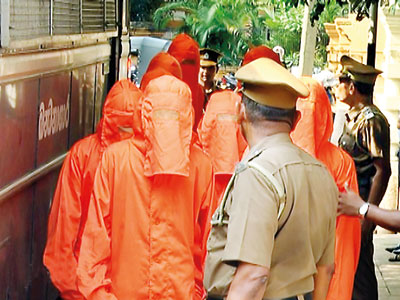News
Red card for orange uniform: New suits for suspects draw criticism from religious leaders
 Justice and Buddhasasana Minister Wijeyadasa Rajapakshe and Prison Reforms and Hindu Religious Affairs Minister D.M. Swaminathan are both claiming ignorance regarding a new uniform introduced by the Prisons Department.
Justice and Buddhasasana Minister Wijeyadasa Rajapakshe and Prison Reforms and Hindu Religious Affairs Minister D.M. Swaminathan are both claiming ignorance regarding a new uniform introduced by the Prisons Department.
Introduced on November 1, the uniform has drawn the ire of Buddhist and Hindu religious leaders who say it offends religious sensitivities.
The new uniforms are worn by suspects when they are taken to courts for identification parades. Fitted with a hood, it covers the body, including the face, completely.
The Prisons Department says the uniforms protect the identity and the privacy of the suspects.
Critics have, however, said that the uniforms which are stitched at the workshop at the Mahara Prison, look at first glance like the robes worn by Buddhist monks or that of Hindu Swamis.
Minister Swaminathan told the Sunday Times there had been no specific discussion between him and prison officials regarding the uniform’s colour. He said he would hold a meeting with relevant authorities to discuss the topic by Monday.
Minister Rajapakshe too said he was unaware of the matter as the subject directly came under Minister Swaminathan. He, however, assured he would look into the matter in his capacity as Minister of Buddhasasana if Buddhist Monks were raising issue.
Buddhasasana Ministry Secretary Wasantha Ekanayake, however, said he was aware of the controversy. He said he believed the  uniforms were being tried out on a trial basis.
He welcomed the move saying it protected the rights of suspects, but said steps must also be taken to ensure that people’s  religious or cultural sensitivities were not offended.
The National Sangha Council (NSC) Secretary, the Ven. Pahiyangala Ananda Sagara Thera, said he too believed that at first glance, it resembled the robes worn by monks.
Apart from religious sensitivity, the Thera said the selection of the colour orange for the uniform was counterproductive. “It is a striking colour and instead of protecting the suspects, it draws the attention,” he said. “There have been incidents of suspects being attacked and sometimes killed inside court premises and such a colour makes them easy targets. A lighter colour would have been more appropriate.”
Holding similar views was the Sri Jayewardenepura University’s Chancellor, the Ven. Prof. Bellanwila Wimalarathana Thera. He said he agreed that the privacy of the suspects should be protected but the authorities could surely have chosen “any other colour that would not be associated with members of the clergy.‚ÄĚ
The prelate said this did not mean that the clergy was laying claim to the colour. It was simply that it has been used for centuries among members of the clergy and as such, it was inappropriate to use orange or saffron colour on a uniform worn by suspects accused of crimes.
Jaffna Tellipalai Thrukkai Amman Hindu Temple Trustee A. Aruthirumurugan felt it was not suitable to use the colour as it was disrespectful to both Hinduism and Buddhism. Authorities should have consulted religious organisations before they decided on the colour, he added.
But Colombo University’s Sinhala professor Ven Agalakada Sirisumana Thera dismissed claims that colour orange was disrespectful of the clergy and Buddhism. ‚ÄúThe colour does not belong to a religion. This is purely an administrative matter and I see no reason how it would negatively impact on Buddhism or monks,‚ÄĚ he said.
The Thera said the clergy should voice their opposition if there are attempts to distort Buddhism. ‚ÄúThis does not fall into that category. There‚Äôs no reason to create an issue when there is none.‚ÄĚ
Prisons Department Spokesman Thushara Upuldeniya acknowledged that some concerns had been raised regarding the new uniform.
‚ÄúThe uniform‚Äôs colour is of no consequence to us and we are prepared to change it from the next batch onward,‚ÄĚ he told the Sunday Times.
Mr. Upuldeniya said the uniforms were introduced because there was no proper clothing to protect the identities of the suspects. Often prison officers had to improvise ‚Äėhoods‚Äô to cover the faces of the people brought for identification parades.
The garment, designed after studying prison uniforms used in other countries, is part of the reforms aimed at ensuring better treatment of prisoners, the spokesman said. Mattresses have been introduced in place of mats for prisoners while their aluminium plates are being replaced by plastic trays, he explained.

